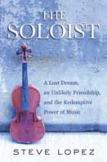Strings on Skid Row
The Los Angeles Times columnist Steve Lopez was heading back to his office one day when he came upon a homeless African-American man playing Beethoven on a battered violin at a busy street corner.
Lopez learned that the man, Nathaniel Ayers, had once been a promising student at the famed Juilliard School in New York City until a mental breakdown cut short his musical career. He ended up on skid row along with countless other mentally ill people.
The Soloist poignantly describes the growing friendship between Lopez and Ayers and the author’s persistent attempts to persuade his homeless friend to move into an apartment and seek help for his schizophrenia. A motion picture based on the book is due out in the fall.
Lopez initially was drawn to Ayers because he sensed the makings of a good newspaper column, but the more they talked the more he began to regard Ayers as a friend. After the first of a dozen columns appeared, Lopez was inundated with e-mails, including offers of instruments. Eventually, Ayers was given two cellos, six violins and assorted other instruments.
The author alternately feels compassion, curiosity and frustration as he tries to understand his friend’s quirky behavior and rapid mood swings. Mental health experts offer Lopez conflicting advice, from forcible treatment to a more benign approach. One doctor tells the author the best thing he can do for Ayers is simply to be his friend.
Fearing the loss of his freedom, Ayers adamantly refuses to move indoors. He has grown accustomed to living out of a shopping cart and sleeping on sidewalks and in traffic tunnels. He is terrified that someone might try to medicate or institutionalize him against his will.
Ayers grew up in Cleveland, where it was apparent that he had enormous musical talent. At Juilliard, he excelled until his third year, when his behavior became so erratic that he ended up in the emergency room of a psychiatric hospital, diagnosed with paranoid schizophrenia and calmed with Thorazine.
Lopez gradually persuades his friend to visit a men’s shelter for meals and showers and, much later, to sleep in his own room there. One day Lopez wrangles an invitation for Ayers to watch a rehearsal of the famed Los Angeles Philharmonic. By now everyone there knows about Ayers because of the newspaper columns, and he is warmly welcomed as a fellow musician.
But Ayers still is troubled by wild mood swings and unpredictable behavior. Lopez frequently despairs, thinking maybe he should forget about Ayers and move on. He also worries about abandoning journalistic objectivity by befriending someone he is writing about and wonders if he is exploiting Ayers by exposing his personal life. The author writes in a chatty style that will draw readers into this saga of a homeless man for whom music is “a meditation, a reverie, a respite from madness.” He wants to believe that with enough support Ayers can escape the claws of his mental illness, but then realizes he probably is deceiving himself. In one scary scene Ayers turns on Lopez, brandishing a trumpet in a threatening manner, screaming profanities and shouting that he never wants to see the author again. Later, he apologizes.
One senses that this friendship has changed Ayers’s life for the better. A doctor cites the importance of relationship and describes how emotional involvement can spark biochemical changes. “You literally have changed his chemistry by being his friend,” he tells Lopez.
But the encounters also have transformed the author, who previously had never volunteered for anything. The experience prompts him to think seriously about giving up his newspaper job in favor of public service. “I wrestled with definitions of freedom and happiness,” he writes, “and wondered at times who was crazier—the man in the tunnel who paid no bills and played the music of the gods, or the wrung-out columnist who raced past him on the way home from sweaty deadlines to melt away the stress with a bottle of wine.”
Readers come away not knowing if Ayers will make it. “I’ve learned,” Lopez tells us, “to accept him as he is, to expect constant backsliding, to prepare for the possibility that he could be homeless again or worse, and to see hope in small steps.”
Although Ayers’s story is memorable, Lopez resorts to the dubious practice of including extended conversations as direct quotations, with no explanation of how he could remember these encounters word for word. Perhaps Lopez carried a tape recorder, but he doesn’t say.
That aside, Lopez has given us a remarkable story, told with sensitivity and insight—one that sheds light on mental illness, homelessness, journalistic standards and, as the subtitle says, “the redemptive power of music.”
This article also appeared in print, under the headline “Strings on Skid Row,” in the June 23, 2008, issue.







